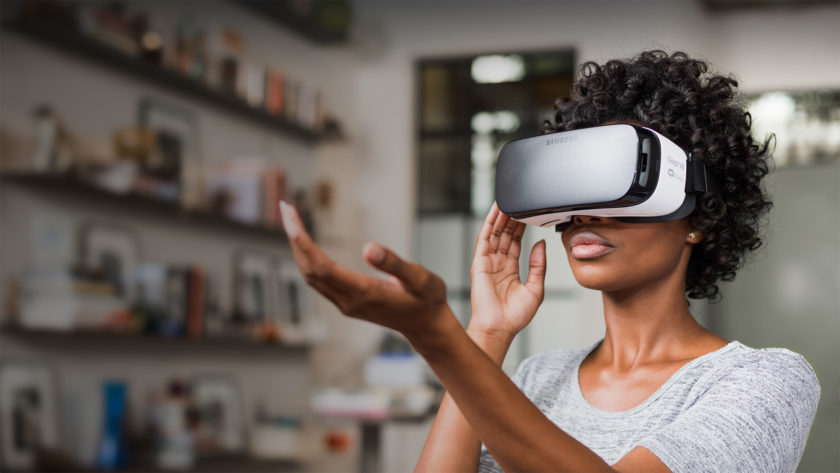M+E Connections

IDC: Global AR, VR Shipments Declined in Q1, But are Expected to Grow This Year
Story Highlights
Global shipments of augmented reality (AR) and virtual reality (VR) headsets tumbled 30.5% in the first quarter of 2018, but are still expected to grow for 2018, the International Data Corporation (IDC) said June 19.
Total AR and VR headsets fell to 1.2 million units in Q1, according to the IDC Worldwide Quarterly Augmented and Virtual Reality Headset Tracker. The research company chalked up much of the decline to the “unbundling of screenless” VR headsets in the quarter.
For much of 2017, vendors bundled those headsets free with the purchase of a high-end smartphone, “but that practice largely came to an end by the start” of 2018, it said in a news release.
Despite the poor start for this year, IDC expects the overall market will return to growth for the rest of the year as more vendors target the commercial AR and VR markets and low-cost standalone VR headsets including the Oculus Go arrive at retail stores, it said.
IDC projected the total AR and VR headset market will grow to 8.9 million units in 2018, up 6% from last year, and that growth will continue throughout its forecast period, reaching 65.9 million units by 2022.
“On the VR front, devices such as the Oculus Go seem promising not because Facebook has solved all the issues surrounding VR, but rather because they are helping to set customer expectations for VR headsets in the future,” Jitesh Ubrani, senior research analyst for IDC Mobile Device Trackers, said in a news release.
He added: “Looking ahead, consumers can expect easier-to-use devices at lower price points. Combine that with a growing lineup of content from game makers, Hollywood studios, and even vocational training institutions, and we see a brighter future for the adoption of virtual reality.”
Many consumers have already AR headsets through screenless viewers including the Star Wars: Jedi Challenges product from Lenovo, IDC said, predicting those types of headsets will top the market in shipment volumes on a short-term basis. But non-smartphone-based AR headsets should start to see larger market availability by 2019 “as commercial uptake continues to rise and existing brands launch next-generation products,” IDC said. It predicted triple-digit growth in that product space between 2019 and 2021.
“Momentum around augmented reality continues to grow as more companies enter the space and begin the work necessary to create the software and services that will drive AR hardware,” Tom Mainelli, program VP of Devices and augmented and virtual reality at IDC, said. He added: “Industry watchers are eager to see new headsets ship from the likes of Magic Leap, Microsoft, and others. But for those devices to fulfill their promise we need developers creating the next-generation of applications that will drive new experiences on both the consumer and commercial sides of the market.”
While major movie properties including “Star Wars” helped sell significant volumes of screenless headsets the past holiday season, “uptake for the remainder of the year is likely to slow as the headsets have limited functionality beyond their core applications,” IDC said.
During the final years of the forecast period, IDC expects such products to decline in relevance, although they are likely to remain in the market, often sold as toys, it said.
Meanwhile, sales of standalone AR head-mounted displays (HMDs) will likely grow to 194,000 units in 2018 and will experience a compound annual growth rate (CAGR) of 190.9% over the five-year forecast. More advanced headsets, including Microsoft’s Hololens and Magic Leap’s One, should “help drive adoption in the commercial and consumer markets,” IDC predicted.
Tethered headsets are expected to grow with a five-year CAGR of 241.8% and that category will be the eventual home of products with lower-cost headsets based on Apple’s recently announced ARKit and Google’s ARCore that tether to smartphones or tablets, IDC said.
IDC predicted VR headset sales will soar from 8.1 million in 2018 to 39.2 million by the end of 2022, representing a five-year CAGR of 48.1%. Although many people may think of VR as a consumer technology, IDC said it believed the commercial market is “equally important” and predicted it will grow from 24% of VR headset shipments in 2018 to 44.6% by 2022.
From a platform perspective, the market has been dominated by Oculus so far, mainly due to the initial large volumes around Samsung’s Gear VR, IDC said. That “will likely continue in the near term as the Go brings VR to more consumers,” IDC said.
But the Oculus platform is “likely to face pressure from both HTC’s Vive platform and Microsoft’s Windows Mixed Reality platform. The latter “should see strong opportunities” in the commercial market as brands including Dell, HP and Lenovo “bring their years of experience catering to enterprise buyers to the market,” IDC said.









